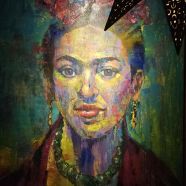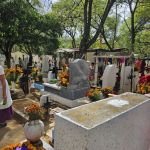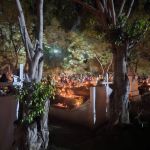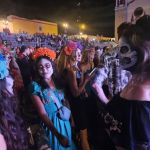Mexico de Nuevo
This fall, South Writ Large magazine asked me to write about my frequent visits to Mexico. I said of course, but you must indulge me if I intersperse the travelogue with bits of musing. Over the years, this place has changed from a favorite getaway spot into a country for which I have a deep affection. This morning I’m in the “salon” of the Red Tree House Hotel in Mexico City. It’s on my list of favorite small hotels in big cities around the world. I’ll be writing this as I roam. I’m indulging in a dia de descanso or time to rest up after a day spent in planes and airports. I need a minute to collect myself, and I can also use the time to write. I’ve been here so often now that I don’t feel the need to be a tourist every visit. A morning at the keyboard is allowed. One reason I’ve always liked to travel alone is that I can change plans at will. Sitting here by the fireplace is part of my new itinerary.
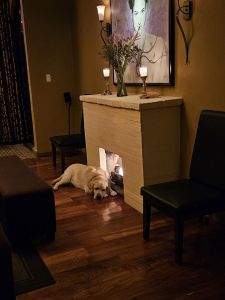
Red Treehouse Inn fireplace
The Red Tree House is in the neighborhood called Condesa, one of this city’s calmer colonias. The population is cosmopolitan; the restaurants are nice. In the past, when I traveled to Mexico, I would mostly find myself in scruffier circumstances. Until recently, most of my trips here have been to visit people who have returned home after having worked for me or the families of those who are still in the United States. These are working people who live in a rougher but still lovely Mexico populated by hardworking families. As my friend Luis Ortega once told me, “It’s a hard life but it’s a good life.” In many ways, I envy him. I’ll see him and his family later on in this trip. Luis and I used to cut up big time when I was in town, but now he’s married, with children, so big family dinners and excursions for ice cream have become the norm. When I’m in Celaya, his hometown up in the state of Guanajuato, I often sit with him in his butcher shop while he works. We don’t talk much, just smile at each other.
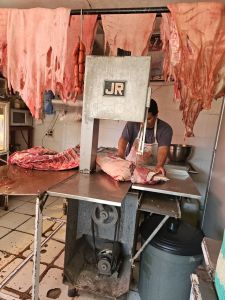
Luis’s butcher shop
I have a lot of other friends in Celaya besides Luis. Another close buddy is Francisco Guzman. I translated all of our pastry recipes at Crook’s Corner into Spanish and then taught him how to make Southern desserts. He was a good pastry chef, but when he got back home, he couldn’t find that kind of job. He now works in a chicharronería—essentially a pork rind factory—in the big central market. I hang out there too some afternoons. For some reason, there is a card table for people to sit at and drink beer right in the middle of the work floor!
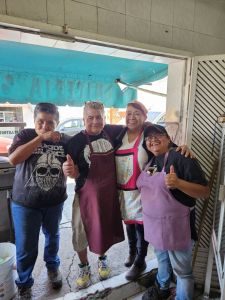
Butchers
In the late eighties and early nineties, Celaya sent hundreds of workers to Chapel Hill and Carrboro. This was perfect for me because my own friends were all settling down and I needed new playmates. I’ve always considered myself lucky the way this worked out. My first visit to Mexico was in 1998 for a wedding. It’s a nice place, but not really a tourist destination—no beaches or ruins to visit. My friends are the attraction. My last few trips here have been a little different though, because of cartel violence that has arrived in the last few years. This plague moves around Mexico, popping up in one place as it seems to disappear from another. It was never a problem in Celaya before, but now I take taxis to do laundry, just in case.
Mexico’s history and culture are complicated and layered. Although it was conquered by Spain, in many ways, the indigenous cultures really won out in the long run and the results are remarkable. Its art is breathtaking. Its food and music are unparalleled. Because I’m now here so often, I’ve gotten fairly accomplished at tracking all of these things down. I’ll add quickly though, that no one could ever visit all of the museums in Mexico.
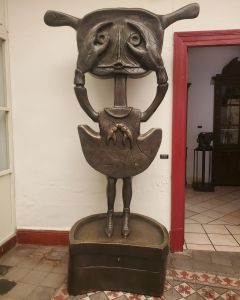
Museum sculpture
One reason that I am here so often these days is because a few years ago, a friend of mine who owns a hotel downtown in the city of Oaxaca decided to start offering food tours. She needed a sidekick with culinary experience, and I had just retired as a chef. The rest is becoming history. I had been to Oaxaca once a long time ago, to attend a friend’s wedding. That was way up in the mountains, and I was in the city only briefly. Now I’m there for weeks at a time and I really am getting to know the place and its culture well. Oaxaca is very different from Mexico City. Celaya and Guanajuato are as well for that matter, and from each other. This trip is taking me to all of these places.
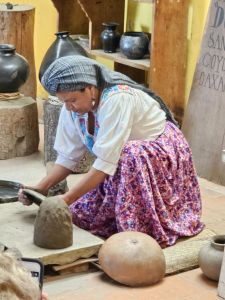
Potter in Oaxaca
****
As is often the case, Mexico City is my base. I’ll fan out to these other cities from there. Now, I am in Oaxaca for a tour that focuses on the festival celebrating Dia de las Muertos. I’ve been working here for several years leading the food tours, but this will be my first time in town for the Day of the Dead.
The vibe in Oaxaca is unique, I think. A general friendliness pervades. There are countless examples of this, but the one I find the most striking is the reception given to the waves of refugees that are constantly crossing the border, mostly from Venezuela and Central America. They are all over the city, asking for handouts. Many of them are small children. After several years of this, the residents still willingly give them food, money, and clothing. Instead of complaining, people talk about how badly they feel for them. The news yesterday predicted that as many as twenty thousand more are on their way up from Chiapas this week. Friends tell me that this generosity of spirit is typical of the Zapotec people who make up most of the population here.
Old university towns in Latin America have a special appeal. They are cosmopolitan and tolerant of difference. They attract artists. Many artists in Oaxaca lean toward graffiti, much of it political. Walls of the city are covered with it, and it is mostly gorgeous. These murals are everywhere. Oddly, or perhaps not, they are often in English. Emiliano Zapata is a popular subject, as are Karl Marx, working people, and all manner of wildlife. There are artist collectives that have workshops around the city. They sometimes welcome visitors as students. There are also remarkable museums that celebrate everything from stamps to textiles to pre-Columbian statuary. Many of the churches could double as museums. The jazz scene is very sophisticated. Dance is so important that there is a weeklong festival every summer to celebrate it.
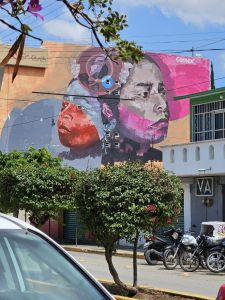
Graffiti
Guanajuato is also an old university town, and like Oaxaca, it is gorgeous. I’m heading there next week. I had been going to see my friends down the road in Celaya for twenty years before I made it to their state capital an hour away. This is an old silver mining town and some of the abandoned mines have been turned into roads beneath the city. In fact, most of Guanajuato is in steep canyons. Almost everywhere you go involves steps. The lovely zocalo, or main square, is a tiny triangle at the bottom of one. There is no flat land here. On one side of the park, there is a remarkable theater in the classical European style, named after Benito Juarez. Juarez was definitely not a Europhile, but President Porfirio Diaz was, and he had the theater built. Both of these presidents were from Oaxaca and had very different views of governance. The first night I was ever in this town, an international flute festival was underway. This is typical of this city. Its most famous event is the Cervantino, a festival that celebrates Miguel de Cervantes, the author of Don Quixote. There is an enormous surrealist statue of Dulcinea, called “La Giganta” in the plaza. It is the work of José Luis Cuevas, one of the many artists of that style who gathered here in the forties and fifties. Others were Remedios Varo and Leonora Carrington. All of their influences persist and to me at least, this helps make Guanajuato’s art quite different from Oaxaca’s. This is also the birthplace of Diego Rivera. His family home is a museum, and there are dozens more. The Museo de Arte Contemporaneo is my favorite.

La Giganta statue
This is a good town for strolling, although clambering might be a better word for how one gets around here. A favorite spot of mine is the Plaza de San Fernando. There is a swanky little place there called the Bar Santos. The owner speaks several languages, and the music is sophisticated. The tiny, ever-changing menu is quite good, even though the kitchen consists of only a blender, a toaster oven, and a hot plate. The front opens onto the park, so it’s a good place to sit and watch.
****
These last few days here in Oaxaca have been remarkable. You can hear parades almost constantly. They’re all over the city. People have put flowers, especially large orange marigolds, everywhere. Last night at midnight, it became All Saints Day. The cemeteries were full of people who had decorated the graves of their loved ones with candles and more flowers. There were bands and beer and lots to eat, but no rowdiness. It is “family friendly” even in the middle of the night. I didn’t get home until after three a.m.
- Graveyard in Oaxaca
- Panteón
- Masked crowd
The next morning was All Souls Day, and we went to the Panteón General. It’s the big cemetery downtown. We were literally swept up in a parade as we entered and the place was mobbed—albeit genteelly, inside. For a few pesos you can hire musicians to sing for you as you clean and decorate the graves. It’s hard to describe the warmth that you feel being here during this fiesta. Everything that comes to mind seems embarrassingly sentimental.

Ofrenda
Tomorrow, I head back up to Mexico City. I got the last seat on the bus. The Red Tree House has a cocktail hour every afternoon. I should get there just in time. It’s always very cordial. It makes you sort of wish that you lived there. I’ll take a day to finish this piece, then it’s up to see my friends.
****
I’ll end this musing, where I began it. In front of the fireplace in the Red Tree House. I got back here to Mexico City yesterday afternoon in time for cocktail hour, just as I’d hoped. I’ve given myself another day here to sit, and then I’m off to Celaya tomorrow to visit my friends. I’ve reached the end of my extended deadline, so I’ll finish up this narrative before I go. These friends that I’m going to visit are really the best part of Mexico to me. In some ways, we are an unlikely match. I’m at least twice their age and on the surface at least, our cultures seem so different. One thing I’ve learned here though, is that people are more alike than they are different. I used to describe my relationship with these guys as examples of the Peter Pan syndrome, but perhaps it’s just me who won’t grow up. They’ve gotten on with things, probably better than I have. Still when we’re back together, it’s as if we’ve never been apart and our friendships are as strong as ever.
*All photographs taken by the author


